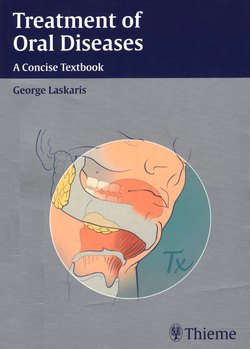Читать книгу Treatment of Oral Diseases - George Laskaris - Страница 22
ОглавлениеAspergillosis
Definition
Aspergillosis is an opportunistic fungal infection with a broad spectrum of clinical manifestations.
Etiology
Aspergillus fumigatus and A. flavus are the main pathogenic Aspergillus species. Immunocompromised patients such as those with HIV infection, neutropenia, leukemia, and diabetes, those receiving immunosuppressant agents and organ transplantation, and patients with chronic respiratory diseases are more susceptible to Aspergillus infection.
Classification
There are several types of Aspergillus infection: a) allergic aspergillosis, b) aspergilloma (fungus balls), c) invasive aspergillosis (pulmonary involvement in 90-95% and extrapulmonary involvement in 20-25%), d) chronic necrotizing pulmonary aspergillosis, and e) superficial aspergillosis with skin, ear, and eye involvement.
Main Clinical Features
The oral mucosa is usually affected in invasive pulmonary aspergillosis. Rarely, the oral lesions are the initial manifestation of the disease.
Oral Manifestations
The oral lesions present as irregular ulcers with a typical yellowish-black surface due to necrosis of the tissues. The lesions are usually localized to the palate, tongue, and lips
Invasive Pulmonary Aspergillosis
Fever, cough, dyspnea, retrosternal and pleuritic pain, and tachycardia are the most common symptoms and signs. However, many patients with invasive pulmonary aspergillosis are asymptomatic
Diagnosis
Oral lesions should be biopsied and histopatho-logically examined. A computed tomography (CT) scan of the chest for suspected pulmonary infection is recommended. Bronchoscopy, biopsy, and respiratory cultures can also be useful.
Differential Diagnosis
•Histoplasmosis
•Mucormycosis
•Cryptococcosis
•Other systemic mycoses
•Agranulocytosis
•Squamous cell carcinoma
•Non-Hodgkin lymphoma
•Malignant granuloma
•Wegener granulomatosis
Treatment
Basic Guidelines
•The treatment of oral lesions of aspergillosis must be undertaken in collaboration with the specialist.
•Invasive pulmonary aspergillosis is one of the most difficult diseases to treat and mortality is high.
•Early diagnosis and early initiation of antifungal treatment are important for a successful outcome.
•Remission and control of the underlying disease are important for a favorable prognosis.
•Relapse may occur.
•The treatment of aspergillosis is always systemic.
Suggested Therapies
•Intravenous amphotericin B is the first-line drug for invasive aspergillosis. The drug must be given only by specialists in a hospital unit.
•Oral itraconazole is an important agent in the treatment of all types of aspergillosis. A dose of 200-400 mg/day is given for weeks to months depending on the type and the severity of the disease. In addition, itraconazole oral solution 5 mg/kg per day is effective.
•Corticosteroids are used only for allergic as-pergillosis.
Future Therapies
Voriconazole and caspofungin seem to be effective in invasive aspergillosis. However, more clinical trials are needed.
References
Andriole VT. Aspergillus infections: Problems in diagnosis and treatment. Infect Agent Dis 1996;5:47.
Johnson LB, Kauffman CA. Voriconazole: A new triazole antifungal agent. Clin Infect Dis 2003;36:630–637.
Kontoyiannis DP, Bodey GP. Invasive aspergillosis in 2002; An update. Eur J Clin Microbiol Infect Dis 2002;21:161–172.
Koss T, Bagheri B, Zeama C, et al. Amphotericin B-resistant. Aspergillus flavus infection successfully treated with caspofungin, a novel antifungal agent J Am Acad Dermatol 2002;46:945–947.
Letscher-Bru V. Herbecht R. Caspofungin: The first representation of a new antifungal class. J Antimicrob Chemother 2003;51:513–521.
Myoken Y. Sugata T, Kyo T, et al. Itraconazole prophylaxis for invasive gingival aspergillosis in neutropenic patients with acute leukemia. J Periodontal 2002;73:33–88.
Rubin AI, Bagheri B, Scher RK. Six novel antimycotics. Am J Clin Dermatol 2002;3:71–81.
